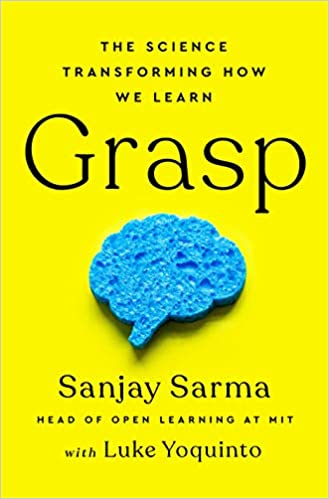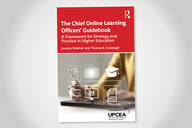You have /5 articles left.
Sign up for a free account or log in.
 Grasp: The Science Transforming How We Learn by Sanjay Sarma and Luke Yoquinto
Grasp: The Science Transforming How We Learn by Sanjay Sarma and Luke Yoquinto
Published in August 2020
Before we talk about why Grasp is an important contribution to the literature on learning science and higher education change, we need to talk about how this book is written.
Grasp is an absolute pleasure to read. Rarely are academic books written with such attention to style.
The quality of the writing in Grasp raises, at least for me, a couple of questions.
My first question is about the audience. Is Grasp intended for a specialized audience of academic educators and university leaders? Or is Grasp written for a nonspecialized readership -- say, anyone outside academia interested in how the scientific understanding of learning is evolving?
My guess is that Sarma and his co-author, Yoquinto (a science writer and researcher at MIT), would say "yes."
Why shouldn't a more general readership be exposed to a detailed, serious and penetrating discussion of the research on learning? Especially if a tightly crafted narrative, and a lyrical approach to the writing, helps to generate a broader audience?
My second question is to ask if Sarma and Yoquinto have raised the bar for the quality of academic writing. But that is a different conversation.
Let's get back to Grasp.
Grasp was written before COVID, but the ideas in the book have never been more relevant. Coming out of the pandemic, higher education will enjoy a set of options and opportunities around teaching and learning that pre-COVID seemed mostly impossible.
We will have a choice. Do we return to the pre-pandemic teaching and learning status quo? Or do we follow the science of learning, and as institutions figure out ways to structure the educational environment in ways that assist (rather than impede) how professors teach and students learn?
The potential gift of COVID will be to have cleared away many of the old ways we've been constructing teaching and learning on our campuses. For something like 1.5 years, we will have lived without large in-person lectures and high-stakes in-class exams. Many schools have stopped requiring achievement/aptitude tests for admissions.
Research productivity has had to take something of a back seat to academic continuity. As educators, we know our students and their home challenges in ways that were maybe opaque pre-pandemic.
Do we want to go back to how things were?
This is a once-in-a-generation opportunity to, as the kids say nowadays, build back better.
If we are going to create a better higher education -- at least when it comes to teaching and learning -- then we should read and talk about Grasp. (And also How Humans Learn -- maybe read the books in conversation.)
Grasp has the learning science angle well covered. Those of us who find ourselves somehow in a job that is all about advancing learning at our institutions, but who (like me) were not trained in any of the disciplines connected to learning science (from cognitive science to learning design) will greatly appreciate Grasp's deep dive into the research.
The other significant contribution that Grasp offers all of us -- both higher ed insiders and outsiders -- is the description of the role that MIT has played in what Eddie Maloney and I have called higher education's turn to learning.
Over the past couple of decades, MIT has been at the forefront of almost every institution-level learning innovation.
Sarma, Gump-like, has been in the middle of seemingly every one of these experiments. MIT is the OG of the open educational resources movement. Out of MIT came the first (and only?) nonprofit open online learning platform (MITx), which quickly developed into edX in partnership with Harvard.
Before I read Grasp, I had known of Sarma's leadership role in open learning at MIT and his long-term service on the board of edX. Sarma is a brilliant speaker, and I've always enjoyed his talks and other opportunities to learn from his expertise.
What I had not known are the particulars of how MITx and edX got off the ground. For those of us curious about how universities do new things, the descriptions of the early sleep-deprived days of Anant Agarwal's work as founder and now CEO of edX are alone worth the time to read Grasp.
What I had not known is that Sarma is the MIT person who conceived of the MicroMasters concept, a system of integrating open online learning with master's degree admissions and study that has the tremendous potential of dramatically lowering students' costs while also diversifying the admissions funnel.
There is much of the MIT story of how teaching can be, if adequately resourced, made to align with the research on learning. Grasp spends a good deal of time with the students and faculty in MIT's famous 2.007 course, Design and Manufacturing 1. In this course, students learn the principles of mechanical engineering not only by listening to lectures and taking tests (they do some of that) but also by building robots and competing in an end-of-semester robotics competition.
Design and Manufacturing 1 is maybe the Platonic ideal of an active and experiential learning course. As Sarma points out, however, 2.007 is not scalable as a solution for all of higher ed. The costs for running the class are so high that universally implementing this approach would quickly bankrupt even the wealthiest of universities.
Grasp also dives into the story of the development of MIT's TEAL classrooms. TEAL stands for technology-enhanced active learning. TEAL is famous for all of us involved in the work of classroom redesign.
Grasp is persuasive in its arguments -- grounded in a thorough historical review of the origins and development of the central debates and findings of cognitive and psychological brain sciences -- that learning is constructed.
If you've ever wondered why our university courses (and ed-tech platforms) often seem more akin to Skinner boxes than to Montessori classrooms, then you should certainly invest in reading Grasp.
The questions I have for Sarma, after reading Grasp, are all about organizational change.
If knowledge is constructed and effective teaching requires an environment that enables students to build their learning, then how do we change our institutions to mirror this reality?
The gap between institutional priorities, organizational structures and learning science seems to be disturbingly wide.
The immediate years following the worst of the COVID-19 pandemic may be our best opportunity to make nonincremental progress in advancing student learning at the scale of the institution.
Grasp can provide the foundations of what learning science-informed teaching might look like, with some fantastic real-world examples of constructivist theory in pedagogical action.
The next step for all of us is to figure out what levers need to be pulled at our institutions to drive organizational changes that align with learning science.
Sarma is better positioned than most to apply the lessons of Grasp to the coming post-pandemic world of higher education.
What are you reading?




